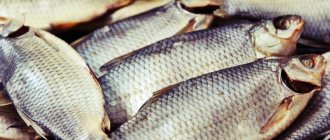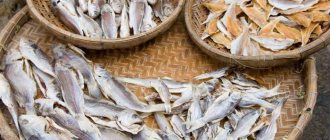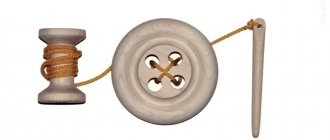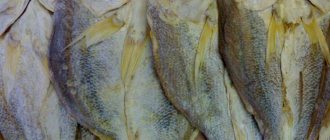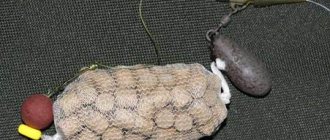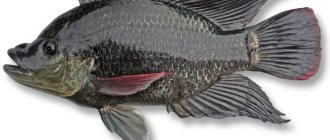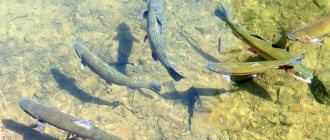Types of networks
For an inexperienced person, all fishing nets are approximately the same. But this, of course, is not true. Nets, just like any other fishing gear, have their own characteristics and classification.
These fishing gears can be divided into three main types:
- Gills or gills (the simplest)
- Ryazhevye (rezhevye), consisting of 2-3 cloths.
- Combined.
In addition, nets are divided into fixed and floating, that is, those that are placed in one place and those that are set adrift or towed by a motor boat or cutter.
Gill nets are also called single-walled because they consist of one sheet. The size of the fish caught in them depends on the size of the mesh, so they make it possible to catch fish of a strictly defined size, while cutting off small things.
A ryazh usually consists of three panels, hence another name for it - three-wall. Between two canvases with a large mesh there is a third one, which has a smaller mesh size and a larger width. When a fish gets into such a net, it pulls the middle web through the large meshes behind itself, thereby forming a kind of bag in which it is securely fixed.
Often, a nylon thread is used to make the outer “walls” of a row, and ordinary fishing line is used for the inner walls. This is done so that the outer sheets can hold large fish caught in the net.
Three-walled nets cannot cut off small things, so it is possible that too many small trash fish are caught in a row net.
All these varieties are mainly fixed. Floating nets include the well-known seine, dragnet, trawl and others.
Combined tackle can combine the properties of different types of nets.
A fishing net can be made from either fishing line or various cords: nylon, nylon, silk and others. Most often, nylon thread is used as a material for the mesh.
A fishing line net is not very durable, although high-quality products are made from twisted fishing line, which greatly increases strength. Nylon tackle, like nylon, is probably the most durable, if, of course, you handle it with care.
Nets are also made from cotton cord, but it quickly becomes unusable, especially if you do not dry the gear after fishing.
Nowadays you can find many different nets on the market, made from different materials by different manufacturers. Fishing nets made in China, the so-called Chinese, are very popular today. Their quality leaves much to be desired, but their cheapness makes the “Chinese” the most common gear.
“Finks,” that is, fishing gear made in Finland or using Finnish technology, are much superior in quality to Chinese ones, but, accordingly, are more expensive.
Also, some craftsmen knit nets with their own hands. This process is quite complicated, but with appropriate preparation it allows you to make tackle of any complexity.
Enveloping (gill) nets
Ryazhe net These nets are a mesh fabric used to directly catch fish that get stuck in it, since the cell of the fabric is larger than the head, but smaller than the body of the fish, and the latter gets its head into the cell and tries to free itself, becoming even more entangled. These networks can be single-walled or three-walled (“ryazhka”). The latter have three webs, only the outermost webs of such a net have a large mesh size and serve to retain fish caught in the net. As a rule, a three-wall is used when catching larger fish: carp, bream, silver carp, and so on. The networks have different lengths from 10 to 150 meters. Separately, we can distinguish small nets (up to 10 meters long) used for catching fish from the shore. This kind of fishing is called “track fishing”. As noted earlier, the installation of the latter is carried out by importing a load with a rubber shock absorber and a float attached to it, for subsequent removal of the load from the water. After flooding, the weights float back to the fishing spot, stretching the rubber, which is subsequently attached to the side cord of the “track”. Having dropped the net into the water, you can safely expect fish to get into the tackle. In this way, active fish are caught that feed close to the shore.
In general, installing a large fishing net is not much different from installing a “path”, but there are some nuances. The network is installed using a boat in which there are two people; it’s possible for one person, but it’s a bit heavy. One carries out the movement of, say, a boat, and the second releases the net. Depending on the conditions of the reservoir and the fish present in it, the net can be placed perpendicular to the shore, along it, or a mixture of both of these options.
Setting up networks
In order to set nets from a boat, a certain skill and at least minimal experience are required. It's easiest to do this together, but it's quite possible to do it alone. But you can use the net without having a boat.
The grid can be installed:
- from a boat;
- wade;
- from the shore;
- under the ice (in winter).
Using a boat, you can place nets in the most interesting places in terms of catch. You can’t do without it on large rivers and lakes.
It should be noted that successful fishing is only possible if the angler knows the reservoir well and the migration routes and stopovers of the fish.
If the fishing net is used in a small body of water, then setting can be done by wading. This method is good in shallow places, and makes it possible to set up various corridors from the nets to catch wary fish, such as salmon.
From the shore it is possible to set it using the so-called drag method; it is performed by two fishermen. The net is “pulled” into the water using a cord with a load, which is thrown to the opposite shore, where a smooth cord from the net is tied to it.
In winter, nets are set by drilling a series of holes through which the net is pulled using a pole with a hook. The method is quite labor-intensive, but if there is a current in the reservoir, tedious drilling of ice can be avoided. The performance is done using a large float, which is set adrift with a flowing cord attached. For such an operation it is enough to drill only one hole.
Fixed networks
- VK
Fixed nets are one of the oldest fishing tools, although they appeared somewhat later than trap and hook gear, but have been known since Paleolithic times. In the old days, the meshes of the net were measured with fingers: you can stick two fingers through - a two-finger net, six - a six-finger net). Other peoples who had stagnated at fairly primitive stages of development also had similar equipment. Content:
- DESIGN
- SINGLE WALL (GILL) NETS
- DOUBLE AND THREE WALL NETWORKS (“PUTANKA”)
- FRAME NETWORKS
ATTENTION! The materials in this section are intended for informational reading only!
The diversity of fishing conditions and fish species has led to the emergence of a variety of types of nets and methods of their installation. The nets are placed at the bottom (bottom), at a given depth in the water column and at the surface, along or at an angle to the bottom line.
Fixed networks are:
- single-walled , the simplest, in which the fish usually gets stuck (bound), clinging with fins and gills (the common name is gill nets);
- two- and three-walled , as well as framed ones , in which the fish gets entangled, wrapping the mesh around itself (the common name is “entanglement”);
- combined , combining features of different types of networks. More complex nets tend to be more catchy and more durable.
According to the method of application, nets are divided into fixed ones, secured with anchors or stakes at the bottom (bank, reeds, etc.) and smooth (drift) nets, drifting with the wind and current. One of the varieties of floating nets is towed nets.
DESIGN
A fishing net consists of a mesh fabric, selection and equipment. The mesh fabric is made from twisted thread or monofilament (fishing line) with a factory mesh size of 6 mm and above. The catchability of a net increases with decreasing thickness of the net thread; nets made from fishing line are more catchy, but they are less durable. Restraints are made from braided cord or twisted ropes. The landing of the mesh fabric on the pick-ups is done manually or mechanized, in various ways, with a landing coefficient from 0.33 (1:3) to 0.5 (1:2).
Fishing net equipment is very diverse. To ensure buoyancy, various types of floats or cords with buoyant filler (foam woven into the cord, etc.) are used. For loading, lead weights, metal rings or cords with weighting filler (in the form of woven weights), etc. are used.
The length of standard amateur networks is usually 25–30 m, which is quite enough, since if necessary, you can always connect several networks into a network of the required length. In addition, the fishing rules of many regions (especially central, densely populated ones) limit the total length of nets to the same thirty meters per amateur fisherman.
The use of longer networks (where they are permitted) requires certain skills in their installation and reassembly. Currently, twisted threads of plant origin (linen, cotton, etc.) are used extremely rarely, in remote places where nets are still knitted in an artisanal way. For the industrial production of networks, exclusively high-strength synthetic materials are used (nylon, lavsan, polypropylene, etc.)
SINGLE WALL (GILL) NETS
A fixed single-wall net is a rectangular mesh fabric placed on the upper and lower ribs and sometimes on the side ribs. The fish gets stuck in it, catching its gills (or rather gill covers; hence the second name) on the mesh meshes. When installing nets of this kind, the pick-ups are stretched horizontally, and the wall of the net hangs vertically.
Single-walled nets give good catches when fish are moving in large numbers. The catchability of single-walled nets increases with the presence of vertical veins, the length of which should be 20% less than the height of the net in the landing. The selection of nets is made longer than the fabric, so that on each side of the net there are free ends 0.5–0.8 m long. These ends, called hooks, are used for tying nets into net formations, as well as for tying to anchors, buoys and stakes .
Planting of nets, as already mentioned, is carried out with a coefficient of 1/2-1/3. Nylon thread is used as a landing thread. The upper part of the net is equipped with floats, and the lower part - with sinkers. The ratio of the lifting force of the floats and the weight of the sinkers is determined by the fishing conditions. If the net must stand on the bottom, then the sinking force of the sinkers must exceed the buoyancy of the floats, which only straighten and support the net fabric in a vertical position. In this case, a certain reserve of excess buoyancy is necessary so that the caught fish or current does not force the net to settle to the bottom.
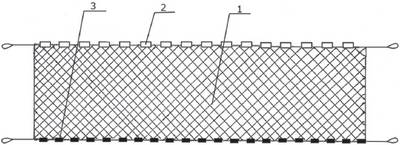
Gill net: 1 – mesh cloth; 2 – load cord; 3 – floating cord
The length of the planted net for recreational fishing is 25–30 m, the height on inland shallow reservoirs is from 1.5 to 1.8 m. On large and deep lakes, nets up to 3–4 m or more in height are used.
Fishing rules in a number of regions limit not only the length of the net and the size of the mesh, but also the height (sometimes you cannot fish with gear exceeding 1.5 m in height). It is more difficult to catch fish in a deep reservoir with a low net, but it is still possible if you have a good knowledge of the horizons on which it rests. In this case, the nets are set using several anchors and ropes strictly at a given depth, and the lifting force of the floating cord must exceed the weight of the cargo cord.
In fact, every self-respecting networker has networks in quantities significantly exceeding those allowed by the rules - very different, for all occasions. But they should be stored at home, because even a dry net lying in the trunk of a car parked on the shore is equated by the rules to being placed in a body of water.
DOUBLE AND THREE WALL NETWORKS (“PUTANKA”)
A two- or three-wall network consists, respectively, of two or three mesh fabrics, planted on common selections, the main small-mesh one is called a “particle”, and the large-mesh ones are called “rezhy” (sometimes “rezhoy”, “ryazhoy”).
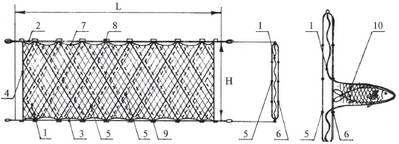
Three-wall network (“tangle”): 1 – mesh fabric; 2 – upper selection; 3 – lower selection; 4 – lateral selection (strap); 5, 6 – cutting; 7 – landing thread; 8 – float; 9 – sinker; 10 – mesh bag (pocket)
The particle is placed between the cutting edges with a large slack, for which the cutting edges are made 1.5–2 times lower than the particle. Therefore, when a fish gets into a particle, it easily drags it through a large cutting mesh and ends up in the resulting mesh bag (pocket). As a result, in such nets the fish not only become entangled, but also become entangled.
The particle mesh size usually ranges from 30 to 60 mm, and the range from 170 to 400 mm. The thinner thread is 4–6 times stronger than that of the piece. Three-walled ones are made of twisted thread and monofilament (fishing line) with a height of 0.7 to 3 m. They are used in calm, quiet water as fixed, smooth and bottomal.
Three-wall nets are the most catchy and durable; they are especially effective for bottom fishing. Bot (tarbat, rattle) means to frighten a fish, driving it out of the reeds, from shallow water and other places, driving it into a net. The catchability of “tangles” is higher than single-walled nets, but their cost is also higher, and disentangling the fish is difficult and requires much more time. This is especially inconvenient when there is a mass movement of fish.
Double-walled rye nets are designed to somewhat improve the price/catchability ratio, but they catch successfully only in cases where the fish approaches the tackle from the side of the main canvas and drags it through a large mesh of rye, getting entangled in the resulting bag. And when setting up a double-walled “tangle”, the fisherman must have a good idea of where large fish are coming from and where in the reservoir. For fish approaching from the other side, the double-wall net works like a regular gill net. The mesh size of the rye is taken to be 4–5 times larger than the mesh size of the main fabric. The height of the ryazhe nets is determined by the height of the ryazhe when planted. Typically, for fixed nets, the height of the tensioned rye is taken to be 30–40% less than the height of the main tensioned fabric. In a correctly planted three-wall network, the cells of both rows coincide (overlap).
FRAME NETWORKS
In a frame (frame) network, the mesh fabric is divided into separate “windows” by sections of thick thread threaded through the meshes along and across the network. The frame network is planted with horizontal and vertical planting coefficients reaching up to 0.33 (or 1:3). As a result of such planting, the network acquires a very large slack - it forms, as it were, a large bag. From one side vein to the other, several longitudinal veins are stretched parallel to the cords, the length of which is equal to the length of the cord. These strings, at a distance of 40–80 cm from one another, are threaded through horizontal rows of mesh nets, and the ends are attached to the side strings. After installing the longitudinal veins, install transverse ones, equal in length to the side veins, at a distance of 40–80 cm from one another.
Each cross-section is secured at one end to the upper harness, passed through a row of mesh nets, and secured at the other end to the lower harness. At places of intersection, the transverse and longitudinal veins are fastened together. Using transverse strands, the previously formed longitudinal bags are divided into a number of small bags, as if planted on the edges formed as a result of the interlacing of the strands, and entangle the fish well, and the load is distributed over a large number of threads, which does not allow even large fish to damage the net.
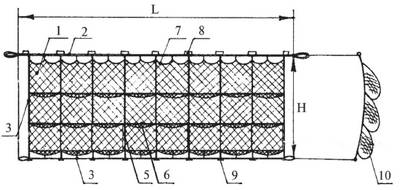
Frame network (three-frame): 1 – mesh fabric; 2 – upper selection; 3 – lower selection; 4 – lateral selection (strap); 5, 6 – cutting; 7 – landing thread; 8 – float; 9 – sinker; 10 – mesh bag (pocket)
The strings are connected at intersections and create frames that prevent fish entangled in the net from removing significant areas of the net from participating in further fishing. The number of frames according to the height of the network determines its name - two-, three-frame, usually the number of frames is no more than eight, frame sizes from 0.6 to 1 m. For the manufacture of frame networks, twisted thread and monofilament (fishing line) are used.
The principle of operation of a frame net is that the fish, having passed through the window of the frame and getting into the net bag, becomes entangled in it, so much so that sometimes it is difficult to disentangle it from the net. The frame net successfully catches both large fish that would not be able to catch in a regular net, as well as small ones. Frame nets, like double-walled and three-walled ones, are used mainly in river and lake fishing. They are also more successful at catching sparse fish than dense schools.
However, if a fish caught in a net can twist a two-walled and a three-walled one over a long distance, then in the frame net only the net bag of one of the windows will twist, and all other areas will be suitable for further fishing. The factory mesh size in frame networks is from 40 to 80 mm.
Frame nets are easier to use than three-wall nets, more durable and catchable than single-wall nets. Frame nets are especially effective in flat, gentle currents and when installed at an inclined angle on shallows, using stakes, for catching large fish - pike perch, whitefish, bream, etc.
A. Shaganov
Related articles:
Catching spring ram
Long cast fishing
Fishing for bream on the current
Methods of fishing with bottom rigs
Knitting nets
For those who are not afraid of long and painstaking work, you can make the network yourself. This will require a fair amount of time and patience, as well as some special tools.
To weave a net with your own hands you will need:
- Shuttle.
- Template (bar).
- Fishing line or cord from which the mesh is knitted.
- Loads.
- Special floats for the network.
The shuttle is a plate with a figured cutout in the upper part. A thread or fishing line intended for knitting is wound onto the shuttle. In essence, the shuttle plays the role of a sewing needle or knitting needle.
These tools must be well treated to remove unevenness, burrs and other surface defects so that the threads do not catch or tear when knitting.
As for the material of manufacture, it can be a nylon fishing line, cotton or nylon thread. The main requirement is strength and the same diameter along the entire length.
Having secured a ring-shaped rope in a convenient place, a loop is tied to it, made at the end of a fishing line or cord wound around a shuttle. This is the start of the network. Next, using a template attached to the first loop, the first mesh of the future network is formed, drawing the thread with a shuttle under the bar and up through the rope ring. The thread on the bar is pressed with a finger, and the resulting loop is tied with a knot. By repeating all these steps, a number of cells are obtained, the width of each should be equal to the width of the future net for fishing.
After the required width has been achieved, they begin to knit the next row of cells, with the difference that the shuttle is now threaded not into the rope ring, but into the cell.
In this way, you can knit any mesh made of fishing line, nylon and other materials, with any required mesh size.
The lower cord, called the cargo cord, is equipped with weights that also have an oblong shape. The weight of the sinkers and the buoyancy of the floats should be enough to ensure that the net in the reservoir stands vertically, without floating up or sinking to the bottom.
The cords are attached in such a way that the finished tackle does not jump off them.
Frame networks: trade secrets
Progress does not stand still. And if previously the secrets of making complex networks were passed down from generation to generation for centuries, now times have changed. The rapid development of technology, the emergence of modern materials - all this entails the modernization of the design and production processes of frame networks.
First, let's figure out what frame networks are? What is their fundamental difference from other types of networks? The mesh fabric of such fishing gear is divided into separate square “frames” by vertical and horizontal veins threaded through the meshes. The veins themselves are made of thick thread. This approach can significantly increase catchability. The principle of fishing is as follows: the fish, having passed through the “window” formed by the veins, pulls the net and, when trying to turn around, gets entangled in the resulting “bag”. More information can be found in the article "What is a frame fishing net?"
The effectiveness of frame nets is especially high when fishing in rivers with weak currents and in lakes. According to statistics, the use of nets of this type is advisable when catching sparse fish, rather than dense schools. Frame nets provide a good catch when hunting not only large fish, but also small individuals. The use of frame nets allows you to achieve 2-3 times more catch than using standard single-wall fishing gear.
The type of network is determined by the number of horizontal rows formed by “frames”. In most cases, networks are two-frame or three-frame.
The production of frame networks is a labor-intensive process. The production of high-quality netting of this type can only be done by a fisherman with many years of experience. Unfortunately, today finding an experienced craftsman is not an easy task. Therefore, the most reliable option is to entrust production to specialists from specialized enterprises. The starting point of production is the choice of high-quality mesh fabric. Russian manufacturers of frame nets prefer Japanese Hameleon nets made of monofilament or twisted fishing line.
Another important aspect is the choice of threads for making veins. The threads must not only be strong and have a perfectly balanced twist, but also have minimal elongation. It is these characteristics that will further ensure the catchability of the frame net.
For a long time, manufacturers framed nets using nylon threads. However, Polytex polyester threads are becoming increasingly popular among industry experts. Unlike nylon threads, polyester threads have almost zero hygroscopicity and do not shrink when in contact with water. This allows you to avoid deformation of the network during operation and maintain its catchability.
Based on materials from the magazine “Fishing and Fish Farming” No. 1, summer-autumn 2017
PVA mesh
Finally, it is worth mentioning one more net, which, although not intended for direct fishing, is an indispensable assistant for carp fishermen. This is a PVA net for fishing, the peculiarity of which is the ability to dissolve in water.
It is made from polyvinyl acetate (abbreviated PVA).
It is intended for spot feeding of the fishing area. Using a special piston with a tube, the net is filled with boilies, pellets or other bait and thrown into the fishing area. The hook with bait is hidden in the net before casting. The PVA mesh in the rig plays the role of a spring or feeder with the difference that not a trace remains of it except a pile of bait at the bottom.
There are several types of such grids:
- Solid.
- Cellular.
- Floating.
- Drowning.
Floating baits are delivered to the site through the water column; this method can be effective when fishing for carp. Sinkers, as the name suggests, dissolve at the bottom, forming a tasty pile of food at the bottom. Solid ones have the appearance and shape of a bag, but do not dissolve very quickly.
Using a PVA net for fishing, you can quickly and accurately deliver bait to the fishing site, which is very important for this type of fishing, such as carp fishing.
This fishing net is the only one that cannot be considered poaching gear. All the rest are classified as prohibited gear and the net can only be used if the fisherman has a commercial fishing license.
It is also necessary to remember that nets that have not been removed or forgotten in a reservoir create a lot of problems for both the inhabitants of the reservoir and the fishermen.
A lot of fish die in abandoned nets. In addition, this is a headache for spinning anglers, bottom fishers, and feeders, who leave a lot of expensive baits and equipment in these traps.
An example of an American-style casting network
two main types of casting gear offered on the shelves of fishing stores
- American.
- Spanish.
The first type is distinguished by its special ease of casting, increased catchability and ease of self-production. But Spanish models are more effective for fishing in hard-to-reach places with inconvenient underwater terrain. They are much less likely to cling to stones, drifts and other obstacles at the bottom.
American casting networks consist of the following elements:
- The net fabric is made of durable monofilament, which is treated with a special agent that provides increased softness and strength. To ensure free opening of the net, it is pre-stretched in production.
- The weight cord is a twist of two polyethylene cords with a smaller diameter, which demonstrate increased strength and wear resistance. When the net is pulled ashore, the sinkers are connected and form a bag where the caught prey accumulates. Casting nets are provided with additional lacing for a strong connection of the cargo cord with the main loads. The weight of each of them is 26 grams.
- To prevent frequent twisting, the tackle is equipped with a carabiner.
- The horn is made of composite materials and is intended for collecting the net in the upper part.
- The fishing line veins are made of high-quality monofilament fishing line.
- The casting cord is made of polyethylene, which does not absorb water, but at the same time maintains excellent buoyancy.
Basic principles for choosing networks
Amateur fishing with nets, which is carried out within the framework of all the requirements of the Law, is a gambling and exciting activity in nature. For many novice fishermen, there is a common concept - “fishing net”. Having decided to engage in such fishing on their own, they end up on the pages of an online fishing net store. There, perhaps for the first time, they see what a huge variety of these gears are available for sale.
Having estimated what size of fish there might be in the upcoming fishing spot, a novice net fisherman who does not have experienced friends among fishermen is almost always doomed to make a mistake in choosing his own gear. The fact is that ordinary gill nets are selective or selective fishing gear. And the principles for choosing the “correct” catching net depend not only on the size of its mesh.
The science of choosing the right net to most successfully catch your target fish is both simple and complex. In order to buy catchable fishing nets , you need to have some experience and knowledge in this field. Fish of the same size have different behavioral characteristics (caution, aggressiveness, endurance, and so on). Naturally, there is no universal net for catching any species of fish. The net must be matched to each fish.
A correctly placed net, which has a del (network) made of the material most suitable for catching a particular fish, will bring the greatest catch. There will be other species in the bycatch, but the selectivity of the right net should work. Types of straining gear such as drags and seines are not considered here. And also Chinese disposable spider nets, designed for the barbaric catching of any fish from water bodies.

What are gill nets
photo network “Finka”
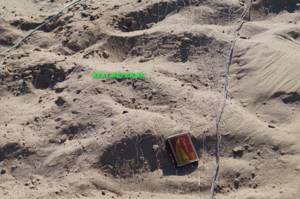
photo network finca
What is a gill net - a single-walled fishing net into the cells of which the fish enters with its head, but due to the expansion of the gills it cannot come back out. Each cell of the net is a trap for a separate fish.
This explains both the names of the nets – gill nets, and their classification according to the mesh size. The larger the fish’s head, the larger the net mesh should be. For example, for catching small bleak, a 10-18 mm mesh is used, for catching large bream, 60-100 mm. For catching medium-sized fish, the most popular are thirty and forty.
There are two types of networks:
- Encircling fishing nets, in which the fish are entangled whole or by the gills. The fish gets entangled in its gills if it is larger than the mesh mesh, for example, when a large bream gets caught in a rye net. SEE ENTRY THREE WALL FISHING NETS. RING NET.
- Straining fishing nets. Such nets have a small mesh and are simply used to enclose the fish and drag them ashore or onto a ship. An example of such networks is a seine, a dragnet.
- Sometimes “trap-labyrinths” are added to the classification of the sete. SEE FOR EXAMPLE THE RECORDING OF VENTER, MEREZHA
If you have read the note GILL NET, then it will become clear to you that gill nets can be:
- single-walled
- double-walled
- three-walled
Let's follow the law when fishing!
Overview of types of nets for catching various fish
The easiest to use and most convenient for beginners and even experienced fishermen are simple set nets. But they are simple only at first glance. This is because networks with the same cell size may have different applications. The catchability of the mesh also depends on the landing (compression) coefficient, which determines the degree of opening of the diamond of each cell. For some types of fish, it is enough to plant the net in a ratio of 1:2 or with K = 0.50 (smelt, vendace, whitefish, pike, salmon and similar oblong fish). Other fish species that have a wide body require less tension on the horizontal corners of the mesh diamond. For more successful catching of such fish (bream, crucian carp, carp, tench, etc.), you need to choose a net with a landing ratio of 1:3 or with K = 0.33. Some types of fish, for example, ide, roach, wild carp and many others, have an intermediate body shape and will fall into both nets. Let's consider the question in more detail.
Entire scientific treatises have been written on determining the size of the mesh for catching the desired fish. Almost 100 years ago, one Soviet ichthyologist derived a formula by which you can find the size (size) of a net mesh for fish of different body shapes.
A=K 1*L Here: A – cell, in mm; L is the biological length of the fish, in mm; K 1 - empirical coefficient of body shape. Fish were divided according to body shape into:
• wide-bodied (carp, bream, crucian carp, tench, roach, flounder, silver bream and others), K1=0.2; • medium-bodied (ide, fisherman, rudd, pike, whitefish, peled, and others), K1=0.15; • narrow-bodied (salmon, pike perch, pink salmon, asp, dace, vendace, smelt), K1=0.1.
Life has made its own adjustments to these theoretical studies. In Russia, for each fishing area (RU) where it is allowed to provide services for organizing fishing with nets, the species allowed for catching with nets are strictly defined, the length of the net and the size of its mesh are indicated. Any deviations from the requirements are punishable by law.
Fixed nets have a variety of fits and additional equipment. They can have a ryazh, a special large-mesh net, planted on the same selections as the main mesh. Working together, the yarn and the canvas (a double-walled net) create bags for large fish. If there are 2 rows, then the net becomes even more catchy (3-wall). Some of the nets are arranged with vertical or horizontal veins, forming large cells - frames. Such frame nets are similar in properties to rownets.
The material from which the net is made is also of great importance when choosing a net for catching a particular fish. The main modern materials for the factory production of nets are synthetic threads:
• nylon or polyamide – traditional high-strength threads for nets; • monofilament thread (monofilament) – transparent fishing line made from a single polyester fiber; • multi-monofilament thread (multi-monofilament) – a transparent thread twisted from several mono-filament lines.
Nylon nets are good in many respects, they are durable and wear-resistant, however, such nets require constant cleaning and drying after each fishing trip. These nets tear less on snags and are cut less by sharp shell rock, especially on the edges of deeper places. Gradually, fishing nets made of nylon are losing ground in the face of new achievements in science and technology for the production of fishing gear, which, a little later, always become available to amateurs. Modern, advanced net fishing enthusiasts are looking to buy fishing nets made from new materials.
Fishing nets. Types and application. Characteristics and installation
In the understanding of modern man, fishing and fishing nets are inseparable concepts. But it was not always so. Man began to fish much earlier than he invented the net. According to A. Brandt, this happened in the Mesolithic era, when people learned to obtain materials for textile production. In those days, the networks were not distinguished by the grace and strength that are inherent in modern specimens. But all the production principles used by our ancestors are still relevant today.
Kinds
All networks are divided into several large groups:
- Fixed.
- Smooth.
- Ram ones.
- Casting.
Fixed fishing nets
They are placed at the bottom, at a given depth or near the surface of the water. They are placed along the bottom or at an angle.
According to their structure, they are divided into:
- Enveloping (gill) - single-walled, consisting of a single panel with links that are larger in size than the fish’s head, but smaller than its body. When a fish lands in a net, it clings to it with its fins or gills (it clings).
- Ryazhevye - two- or three-walled. Finding himself in them and trying to free himself, the victim becomes even more entangled. Hence their common name - “confusion”. The outer wall of the mesh can have large cells to keep the fish inside. The outer walls are most often made from nylon thread, and the inner walls are made from fishing line.
- Combined. They are composed of various fabrics to combine their properties.
An interesting option for a fixed net are the so-called “muzzles”. These are cone-shaped tackles that are installed at the bottom. When weaving them, willow branches are used. They leave bait in the “muzzles”, the fish swims into them, and the design of the “muzzle” does not release it to freedom.
Smooth Networks
They are hunted directly from the watercraft. Smooth nets trail behind the ship and capture fish moving towards them.
Types of smooth networks:
- “TV” is a two-meter tackle that is lowered from two boats or thrown from the shore in places where wildlife accumulates.
- “Klondike” is a triangular net used during the cold season, when fish concentrate at the bottom.
- “Track” is a single-wall sheet of fishing line with a rubber shock absorber. It is installed in small reservoirs and combined with fishing with a rod.
Floating nets include a trawl - a large cellular bag made of nylon, towed behind a sea fishing vessel. The trawl is designed for industrial-scale fishing.
Frame fishing nets
Designed for fishing on the current. This is gear divided into separate large pockets by thick thread. The fish linger in these pockets.

Frame meshes come in any size and differ in type of material:
- Line fish - suitable for bodies of water where there is a lot of algae or where the water “blooms”. Small plants stick to the fishing line and it becomes invisible.
- Nylon ones are distinguished by their durability; they are used in clean reservoirs with strong currents.
Casting networks
They are also called caps. They are round in shape, equipped with weights, and in the center there is a rope with a carabiner. The net is collected in the hand in a certain way and thrown into the water. It lies on the bottom under the influence of weights, covering and entraining the fish, and they are pulled out with the existing rope.
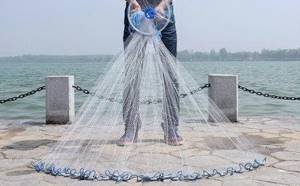
Divided into:
- American ones are easier to cast and provide a good catch.
- Spanish ones cling less to rocks, so they are convenient for uneven bottom topography.
Seine
“The old man threw a net” - everyone probably remembers this fairy tale. Seines should be mentioned separately, because these are the most ancient fishing nets. It is usually used in industrial fishing, but seine nets are also often used by fishermen living near large bodies of water. There are a lot of types of seines, but the most common ones can be called cast-in, throw-over and bottom.
A cast net is an arc that is cast from the shore or from a boat. Along its edge there are weights that, when the seine is immersed, turn it into a large bag. When pulled ashore, the bag closes and carries the caught fish along with it.
New materials for nets - new opportunities in fishing
For more than 10 years, Russia has been supplied with the world's best samples of Japanese-made monofilament and multimonofilament netting from the MOMOI FISHING company. The peculiarity of these nets is that they are practically invisible to fish even in clear water. When these threads are in water, they become softer after a while. This also increases catchability, especially for cautious fish.
Scientists and technologists from Japan have gone further. Through many thousands of tests and experiments, they proved that a multi-monofilament thread, say with a diameter of 0.24 mm, twisted from three monofilament threads with a diameter of 0.08 mm, has different physical properties than a monofilament of the same diameter - 0.24 mm.
With the advent of the multimonophyll, fishermen who love net fishing have a real opportunity to measure their strength with such a strong, smart, cautious and swift fish as wild carp. Carp will always break weak nets. You can put thick nylon nets on carp, choosing a thick thread that can withstand a motorcyclist, but there will be no success in fishing. Carp, even in muddy water, sees and is afraid of both the nylon net itself and its shadow. He probes the network with his sonar-whiskers, starting from the top to the very bottom. If the net is not trampled into the ground, the carp makes a dig, marks it with its pheromones and leaves. The whole flock leaves after him. Sometimes the carp jumps over a noticeable net. Occasionally, a flock of carp makes a breakthrough and breaks the net with a concentrated blow. Such numbers do not work with a multimonofilament network.
The latest nets, which have a ready fit, are available in the online fishing net store. They are knitted in Japan from special polymer-coated threads. The nets go on sale under the Chameleon brand. The main advantage over conventional networks is their stealth. Chameleon nets are made from all three types of materials: nylon, monofilament line and multi-monofilament line. Depending on the fit, they are divided into groups: Chameleon STANDART (machine fit with pick-ups), Chameleon EXTRA (manual fit), Chameleon SPRUT (three-wall manual fit). This series of ready-made nets is the best that modern industry and the development of technology can offer for fishermen who love this type of fishing.
Fishing with netsAnton Shaganov, 2009
Manufacturing of networks
Should I buy a ready-made network or make it myself? Everyone decides this question for themselves. Twenty or thirty years ago, when netting tools could only be bought under the counter and for a lot of money, they were available only to poachers catching fish for sale, and many amateurs spent long winter evenings knitting netting.
Now the situation has changed - affordable nets are available in almost every store that sells fishing supplies. But anglers are not always satisfied with their quality and compliance with specific fishing conditions. Therefore, most amateurs choose an intermediate option - they make nets themselves, but from purchased materials: net fabrics (the so-called “dolls”), racks, cargo and floating cords.
The main points you need to know before purchasing netting supplies are:
— what types of fish will become the object of fishing;
— the size of the reservoir where the networks will be used;
— depth of network installation;
— bottom configuration at the fishing site.
The most important characteristics of mesh fabric are length, height, mesh size, and thread diameter. The length and height of the mesh fabric are determined in a stretched state. For example, if it is indicated that the mesh fabric has dimensions of 1.5 x 60, this means that with a height (depth) of 1.5 m, the length of the fabric is 60 m.
When choosing a mesh fabric for self-planting a network, first of all pay attention to the mesh pitch.
Fine-mesh nets (mesh less than 20 mm) are used for catching small but valuable schooling fish (vendice, ripus, smelt), as well as for catching live bait when it is required in large quantities, for example, for multi-hook nets.
To catch small fish, the most common in Russian water bodies (that is, perch and roach), amateurs most often use single-wall nets with a mesh size of 27–32 mm. A pike weighing up to 1 kg can also get caught in the same net, being caught not by its gills, but by the bony protrusions on its lower jaw, and sometimes even managing to wrap the net around its tail. For fish in which the ratio of body width to length is increased (bream, crucian carp, etc.), a net with a large mesh size is required.
To catch the largest fish, large-mesh nets are used, in recreational fishing, usually with a mesh pitch not exceeding 120–140 mm.
Ryazha on two and three-wall nets (sometimes called ryazha or rezha) are installed with a mesh from 170 to 400 mm. The thread on the yarn is 4–6 times stronger than that of the mesh fabric.
Types of fishing nets
There are many types of fishing nets. They are united by the presence of mesh fabric and equipment, but even these design elements may have differences.
The types of fishing nets and their names are well known to professionals, but amateurs also try to keep up, understanding that when purchasing, you need to indicate a certain type, and not try to explain to the seller “on your fingers” what you need.
Perhaps the most common are single-wall networks.
They are simple to use, inexpensive, easy to install and remove, and difficult to confuse. The main criterion for choosing a model is the size of the cells, since each type of fish and fishing conditions have their own variations. These types of fishing nets are also called gill nets, since the prey becomes entangled in the cells, caught in the gills or fins. A classic design is considered to be 30 meters long and 1.8 meters high, equipped with cargo and float cords. Typically the top cord has a buoyancy of 6 g/m. You should not chase the “stronger” one, as it can reduce the productivity of the tackle. As for the mesh fabric, it can be made of synthetic thread (polypropylene, lavsan, nylon) or fishing line - the choice depends on your preferences.
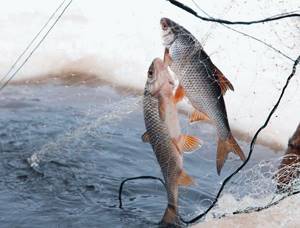
The next most popular types of fishing nets are three-walled ones.
They are quite labor-intensive to install, require a certain skill, and an inexperienced fisherman can tangle the canvas. The difference from single-walled models is that on both sides of the piece (main fabric) there are nets (ryazhi) with cells up to 300 mm. Similar structures are installed on the current - under its influence, the ridge swells, allowing fish to pass through, which rests against a particle, tries to turn around and gets entangled in the net. Due to their catchability and ability to catch large fish, these types of fishing nets are deservedly popular.
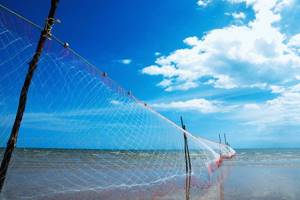
Frame models are characterized by the fact that the fabric in them is divided by veins of high-strength thread threaded through the cells into separate “windows”.
Thanks to the landing coefficient, peculiar purses-bags are formed that “confuse” the catch. The caught fish cannot damage them, because the veins evenly distribute the load over the entire area of the canvas.
When considering the types of nets for fishing, we must not forget about casting models.
They require special skills from fishermen, because they must be thrown into a body of water, having first been wound around the hand, so that “in flight” the canvas unfolds, covering the selected area of the water surface. Thanks to the sinkers, the net sinks to the bottom, after which it can be pulled out by pulling the braided seven-millimeter polyethylene cord and the caught individuals can be selected. One of the varieties of casting models is called “American type”. These types of fishing nets differ in that the “American” one has a vein (5 mm in diameter), which pulls the net fabric into the bag, where the exit is blocked by weights (each about 26 grams). Thus, the caught fish cannot escape while remaining inside.
What is the name of the fishing net? Fishnet
Today we will talk about what types of fishing nets there are. How to choose the right one and let's see what they are.
First, let's figure out what shapes fishing nets come in:
- box-shaped,
- stock,
- conical,
- crab,
- casting,
- crayfish net,
- immersion networks,
- flag,
- gills,
- redheads,
- network hoop,
- rise or fall networks,
- alive,
- shad scoop,
- seiners,
- tamping,
- trawls,
- umbrella,
- fishing nets,
- alloy,
- fishing nets with elastic.
Don't be intimidated by the variety of fishing nets.
Most of them are used directly in industrial fish production.
Now let's look at each type of network separately:
Box fishing net.
It is usually used with a feeder.
Installed on the bottom of the reservoir.
Afraid of strong currents.
Effective for catching bottom fish.
These networks are further divided into several types:
- knotless,
- nodal,
- knotless with retention,
- nodal with retention.
Nodeless networks.
Nodeless networks are those networks in which the forming cell has no nodes.
Such a network allows cells to become smaller or larger.
Basically, this is a big plus, since when catching small fish, it can escape into a large, extended cell.
The downside of such a net is that after fishing you need to sort through the net and arrange the cells according to size.
Nodal networks.
The first time you use a knotted fishing net, you will feel a big difference compared to a knotless net.
Such a network has a cell fixed on all sides by nodes.
The knots prevent the cell from deforming and it is much easier to operate.
But there is also a minus - this is the size of the network cell.
For each type of fish, you need to select a specific net with a mesh size.
Another disadvantage is that the fish gets entangled in it a little worse, since the cell is not deformed.
Knotless fishing nets with retention.
Similar to the principle of nodeless networks, these networks have a sliding cell.
An addition to a nodeless network is one end of the network assembled into a node.
In my practice, I came across one of these.
After fishing, it was necessary not only to disassemble the net, but also to lay it out correctly for the next use.
I didn’t like fishing with her, although it can be noted that the catch was simply enormous.
I have no idea what caused the big catch.
Knotted fishing nets with retention.
These networks are popularly called a casting network.
It can be cast both from the shore and from a boat.
Very common among fishermen with different experience.
It has a central part with a rope and a bypass leash for closing the net.
I can’t point out any particular shortcomings. The only thing is probably the small area of water coverage.
You will feel the advantages yourself when you fish with it.
Stock fishing net.
This net is usually used to catch crustaceans.
It has one entrance in the form of a valve that prevents exit.
It can also catch bottom fish.
Used with a feeder or groundbait.
It is installed both on the bottom of the reservoir and on the surface of the reservoir, on floats.
Looking at the shape of this net, you can immediately guess that the hole for the fish to enter is of a certain diameter.
If you have a diameter of about 30-40 cm in the running tube, then you can’t count on big fish.
What is the name of the net in which fish are placed when fishing?
Every fisherman knows what a cage is. A fish tank is a device for storing fish while fishing. The caught fish is laid down
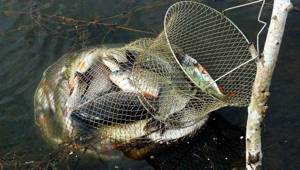
I think for fishermen this question will seem very easy.
Of course, I’m not very keen on fishing, it’s very boring for me to sit and wait for a fish to bite, but I also know the answer to this question.
My dad has such a metal fish tank, he always takes it with him when fishing, such a fish tank can be lowered into the water with the catch and the fish will remain alive.
Every fisherman knows about this device. It is used to place fish in it while a person is fishing. This way the fish stays fresh longer, it is alive in it.

